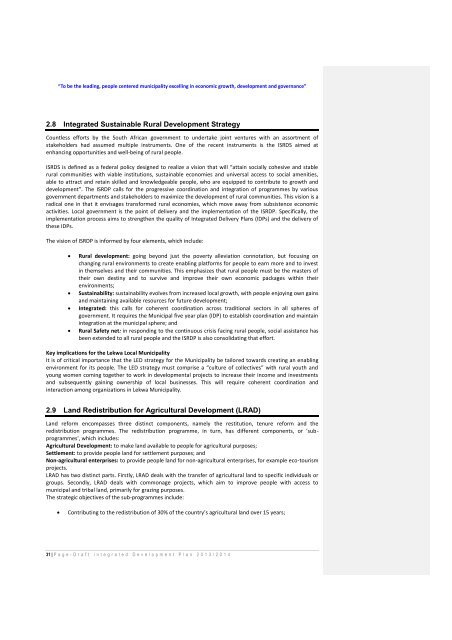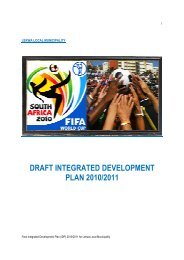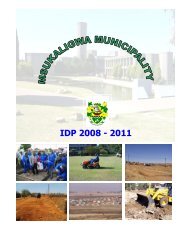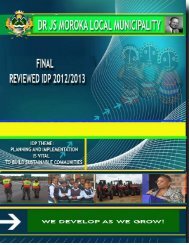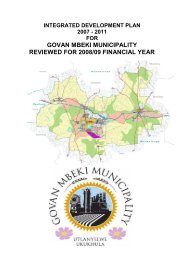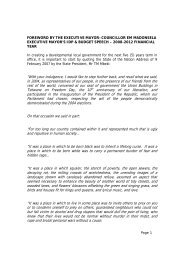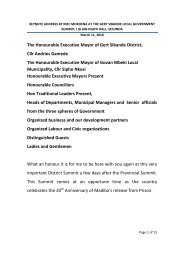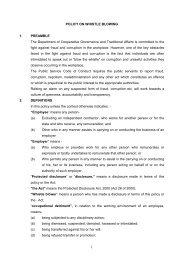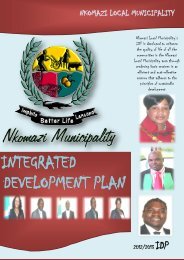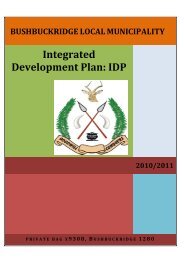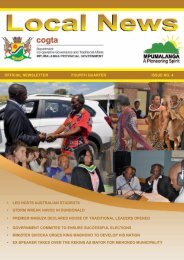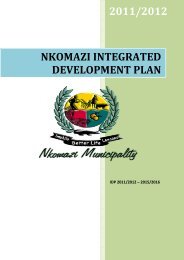Lekwa Local Municipality 2013/14 - Co-operative Governance and ...
Lekwa Local Municipality 2013/14 - Co-operative Governance and ...
Lekwa Local Municipality 2013/14 - Co-operative Governance and ...
Create successful ePaper yourself
Turn your PDF publications into a flip-book with our unique Google optimized e-Paper software.
“To be the leading, people centered municipality excelling in economic growth, development <strong>and</strong> governance”2.8 Integrated Sustainable Rural Development Strategy<strong>Co</strong>untless efforts by the South African government to undertake joint ventures with an assortment ofstakeholders had assumed multiple instruments. One of the recent instruments is the ISRDS aimed atenhancing opportunities <strong>and</strong> well-being of rural people.ISRDS is defined as a federal policy designed to realize a vision that will “attain socially cohesive <strong>and</strong> stablerural communities with viable institutions, sustainable economies <strong>and</strong> universal access to social amenities,able to attract <strong>and</strong> retain skilled <strong>and</strong> knowledgeable people, who are equipped to contribute to growth <strong>and</strong>development”. The ISRDP calls for the progressive coordination <strong>and</strong> integration of programmes by variousgovernment departments <strong>and</strong> stakeholders to maximize the development of rural communities. This vision is aradical one in that it envisages transformed rural economies, which move away from subsistence economicactivities. <strong>Local</strong> government is the point of delivery <strong>and</strong> the implementation of the ISRDP. Specifically, theimplementation process aims to strengthen the quality of Integrated Delivery Plans (IDPs) <strong>and</strong> the delivery ofthese IDPs.The vision of ISRDP is informed by four elements, which include:Rural development: going beyond just the poverty alleviation connotation, but focusing onchanging rural environments to create enabling platforms for people to earn more <strong>and</strong> to investin themselves <strong>and</strong> their communities. This emphasizes that rural people must be the masters oftheir own destiny <strong>and</strong> to survive <strong>and</strong> improve their own economic packages within theirenvironments;Sustainability: sustainability evolves from increased local growth, with people enjoying own gains<strong>and</strong> maintaining available resources for future development;Integrated: this calls for coherent coordination across traditional sectors in all spheres ofgovernment. It requires the Municipal five year plan (IDP) to establish coordination <strong>and</strong> maintainintegration at the municipal sphere; <strong>and</strong>Rural Safety net: in responding to the continuous crisis facing rural people, social assistance hasbeen extended to all rural people <strong>and</strong> the ISRDP is also consolidating that effort.Key implications for the <strong>Lekwa</strong> <strong>Local</strong> <strong>Municipality</strong>It is of critical importance that the LED strategy for the <strong>Municipality</strong> be tailored towards creating an enablingenvironment for its people. The LED strategy must comprise a “culture of collectives” with rural youth <strong>and</strong>young women coming together to work in developmental projects to increase their income <strong>and</strong> investments<strong>and</strong> subsequently gaining ownership of local businesses. This will require coherent coordination <strong>and</strong>interaction among organizations in <strong>Lekwa</strong> <strong>Municipality</strong>.2.9 L<strong>and</strong> Redistribution for Agricultural Development (LRAD)L<strong>and</strong> reform encompasses three distinct components, namely the restitution, tenure reform <strong>and</strong> theredistribution programmes. The redistribution programme, in turn, has different components, or 'subprogrammes',which includes:Agricultural Development: to make l<strong>and</strong> available to people for agricultural purposes;Settlement: to provide people l<strong>and</strong> for settlement purposes; <strong>and</strong>Non-agricultural enterprises: to provide people l<strong>and</strong> for non-agricultural enterprises, for example eco-tourismprojects.LRAD has two distinct parts. Firstly, LRAD deals with the transfer of agricultural l<strong>and</strong> to specific individuals orgroups. Secondly, LRAD deals with commonage projects, which aim to improve people with access tomunicipal <strong>and</strong> tribal l<strong>and</strong>, primarily for grazing purposes.The strategic objectives of the sub-programmes include:<strong>Co</strong>ntributing to the redistribution of 30% of the country’s agricultural l<strong>and</strong> over 15 years;31 | P a g e - D r a f t i n t e g r a t e d D e v e l o p m e n t P l a n 2 0 1 3 / 2 0 1 4


